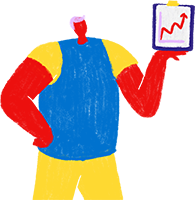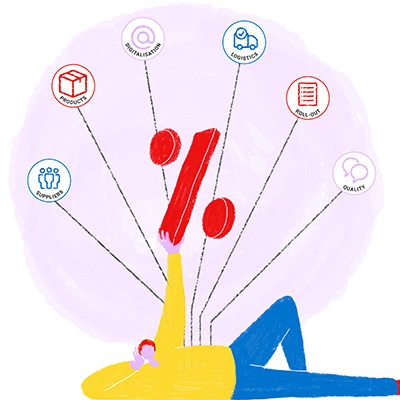Managing operating costs represents a strategic challenge for all companies, whether they are in a growth or consolidation phase. Knowing how to analyse, control and optimise all expenses related to daily operations enables sustainable improvement of profitability and competitiveness.
What are operating costs?
Operating costs encompass all expenditures necessary for the smooth running of a company's daily activities. They form the foundation upon which operational performance and the ability to generate turnover rest.
These costs can be classified into two main categories:
- Fixed costs: These are operating costs such as constant expenditures, like rent, wages, or service subscriptions;
- Variable costs: They evolve according to activity, such as the purchase of raw materials, logistical expenses or costs linked to production.
It is important to distinguish operating costs from investment expenses. The former concern current expenditures, necessary for daily operations, whilst the latter are linked to the purchase of durable goods (machines, vehicles, property taxes) intended to increase production capacity or improve efficiency in the long run.
Methodology and key indicators for analysing operating costs
Good management always begins with rigorous evaluation. This involves measuring expenditure items, categorising them, then detecting improvement potential.
Analysis methodology
To conduct an effective analysis, it is recommended to follow several steps:
- Data collection: Centralise all information relating to expenditures via accounting, management tools and bank statements;
- Expense classification: Group expenditures by category (personnel, maintenance, supplies, utilities, etc.) to facilitate identification of the main cost items;
- Ratio calculation: Put each cost into perspective in relation to turnover or other relevant indicators (average cost per employee, operating cost per unit produced, etc.);
- Benchmarking: Compare the ratios obtained with those of similar companies or with sector standards to evaluate relative performance;
- Gap analysis: Identify significant gaps and investigate their causes (overconsumption, unsuitable contracts, inefficient processes...).
Performance indicators (KPI)
To effectively manage operating costs, it is essential to rely on performance indicators, such as:
- The rate of operating costs on turnover;
- The average cost per employee;
- The evolution of expenditures linked to purchases;
- The number of active suppliers;
- The average order processing time;
- The equipment utilisation rate.
These KPIs allow tracking the impact of actions undertaken and adjusting the strategy in real time.
How to implement an operating cost optimisation strategy?
Once diagnostics are established, it's time to act. It's not about cutting budgets arbitrarily, but about intelligently optimising internal processes. Several levers can be activated to optimise operating costs:
- Supplier rationalisation: Reducing the number of partners allows concentrating purchase volumes, negotiating better pricing conditions and simplifying administrative management;
- Contract negotiation: Regularly renegotiate purchase and service contracts to benefit from the best market offers and adapt services to real needs;
- Process automation: Digitalise the management of purchases, orders and invoices to gain efficiency, reduce errors and limit manual tasks;
- Expense control: Establish clear procurement policies, budgets per service and validation procedures to avoid drift and make teams accountable;
- Stock optimisation: Adapt stock levels to real needs to limit storage costs and obsolescence risks.
These targeted actions can generate significant savings in the short and medium term, as highlighted in the Ernst & Young report, Focus on the UNSPSC from June 2023: "We estimate organisations can achieve cost savings of at least 10% – 15% from their current spend baseline by addressing tactical opportunities while building toward an integrated spend management approach.”
The procurement department occupies a central place in managing operating costs. It is responsible for supplier selection, price negotiation, contract management and digitalisation of transactions. By working closely with other services, the procurement function contributes to aligning objectives and creating value for the entire company. It also plays a key role in implementing innovative solutions, such as e-procurement or advanced analysis of procurement data.
Tools and technologies to optimise operating costs
Optimising total operating costs now requires adopting digital and technological solutions adapted to each sector of activity.
Process automation
Automation enables reducing repetitive and time-consuming tasks, whilst limiting human errors. It applies to many domains:
- Administrative management: Automation of invoicing, payroll, bank reconciliation and expense tracking;
- Procurement management: Order automation, invoice validation, supplier contract management;
- Predictive maintenance: Thanks to IoT (Internet of Things), it is possible to monitor equipment in real time and anticipate failures, thus reducing repair and production stoppage costs.
Management software solutions
The use of specialised software enables centralising and optimising resource management:
- ERP (Enterprise Resource Planning): These platforms integrate accounting management, purchases, stocks, production and human resources, offering a global vision and facilitating decision-making;
- CRM (Customer Relationship Management): Improves customer relationship management, reduces costs linked to errors and optimises sales tracking;
- Project management tools: Facilitate planning, task tracking and team collaboration, thus limiting delays and budget overruns.
Document digitalisation and collaborative working
Electronic document management (EDM) and collaborative tools enable:
- Reducing costs linked to printing, physical storage and archive management;
- Facilitating information sharing and remote collaboration, particularly via cloud platforms (Google Drive, Microsoft Azure, Slack, Trello...);
- Optimising multi-site management and remote working by centralising data and tracking remote collaborator expenditures.
Data analysis and artificial intelligence (AI)
Advanced data analysis and AI offer new optimisation levers:
- Expense analysis: Identification of cost items to optimise, anomaly detection and real-time tracking of key indicators;
- Prediction and optimisation: AI enables anticipating needs, optimising stocks and adjusting processes to reduce waste.
Cloud solutions and outsourcing
Using cloud and outsourcing certain functions (payroll, IT, customer support...) enables:
- Reducing material investments and maintenance costs;
- Pooling resources and benefiting from economies of scale;
- Accessing high-performance tools without mobilising heavy infrastructure budgets.
Proactive management of subscriptions and licences
To avoid unnecessary expenditures, it is recommended to:
- Regularly review software subscriptions and remove duplicates or obsolete tools;
- Favour free or open-source solutions when possible.
Case study: Optimising operating costs through digitalisation
A medium-sized industrial company, present on several sites in Europe, embarked on an approach to optimise its operating costs, particularly on non-strategic purchases (office supplies, PPE, maintenance equipment...).
Its objective is to reduce expenditures linked to indirect purchases whilst securing supply and freeing up time for operational teams.
The initial analysis highlighted:
- A portfolio of more than 500 suppliers for similar product families;
- Decentralised orders without systematic procurement validation;
- Significant price gaps for equivalent products;
- A lack of visibility on overall expenditures, distributed across several unconnected systems.
The actions implemented:
- Audit of operating costs by category;
- Supplier panel rationalisation (objective: -40%);
- Implementation of a single e-procurement tool connected to the ERP;
- Standardised product catalogues by site;
- User training on the new platform.
The results obtained in 12 months:
- Reduction of operating costs linked to indirect purchases by 22%;
- Reduction of order processing time by 40%;
- Decrease in maverick spend rate by 60%;
- Better expense visibility for management controllers.
Thanks to process standardisation and digitalisation of transactions, the company was able to regain a profitability lever without compromising service quality for its employees.
Rationalising operating costs is a continuous approach, which relies as much on detailed analysis as on well-managed strategic choices. By integrating appropriate digital solutions and efficiently structuring the procurement function, companies can significantly improve their profitability without compromising their service quality.









